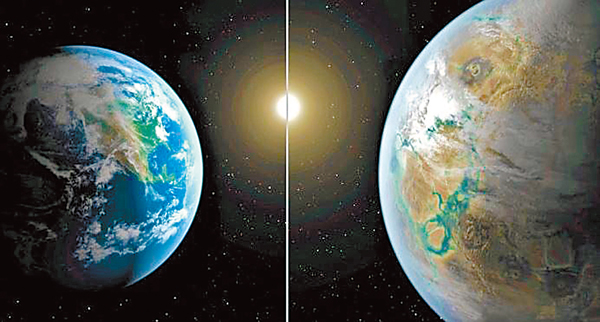 ■科學家新發現的宜居星球質量約為地球的1.3倍。 網上圖片
■科學家新發現的宜居星球質量約為地球的1.3倍。 網上圖片下文摘錄自香港《文匯報》8月26日報道:
【原文】國際科學團隊在8月24日出版的科學期刊《自然》(Nature)發表新研究成果,指在距離地球僅4.2光年(light year)的地方,發現與地球大小相似的岩石行星(rocky planet),可能有液態水(liquid water)和生命。有學者指出,這顆星球距離較近、且處於「宜居帶」(habitable zone),有機會成為人類進行太空殖民(space colonization)的新希望。
這顆「新地球」名為「比鄰星b」(Proxima b),它圍繞距離太陽最近的恒星「半人馬座比鄰星」(Proxima Centauri)運轉,公轉一圈僅需11天,遠較地球圍繞太陽所需的365天為短,質量(mass)約為地球的1.3倍。
處「宜居帶」或有水 利生命繁衍
比鄰星b與恒星之間的距離為700萬公里,比地球與太陽之間的距離近20倍。這本應導致溫度太高難以孕育(harbor)生命,但半人馬座比鄰星由於是一顆「紅矮星」(red dwarf),表面溫度(surface temperature)遠低於太陽,亦比太陽暗淡(faint)1,000倍,比鄰星b接收到的能量大約為地球所接收太陽能量的70%。因此科學家估計,比鄰星b仍是處在「宜居帶」上,理論上適合液態水存在,有利生命繁衍。科學家嘗試拍下比鄰星b的照片,了解它是否擁有大氣層(atmosphere)和水,進而探測(detect)大氣層是否有甲烷(methane)等在生物體內所含有的化學物質。
英、美、法、德和智利等多國研究人員(researcher)組成的國際團隊,利用歐洲南方天文台(European Southern Observatory)望遠鏡(telescope)及其他設施觀測,發現半人馬座比鄰星附近有行星運行的痕跡,隨後多次觀測最終證實比鄰星b的存在。這亦是自1995年以來在太陽系(solar system)外發現的3,500多個星球當中,最接近地球的一個。在此之前,已知最接近地球的適居星球為「Wolf 1061c」,距離地球約14光年。
輻射超地球100倍
比鄰星b是一顆「潮汐鎖定」(tidally locked)的行星,意味它的一面永遠對恆星,而另一面則始終處於黑暗之中。根據電腦模型數據,比鄰星b如果擁有大氣層,星球溫度將介乎攝氏零下30度至攝氏30度。此外,由於比鄰星b相對接近其恒星,因此將承受較大的輻射(radiation),比地球從太陽所承受的程度高出100倍,恐會減低行星上存在生命的機會。
無論如何,科學界對這次發現大為振奮,天文學家將對比鄰星b展開更全面(comprehensive)觀測(observation),它將成為人類搜尋地外生命(extraterrestrial life)存在證據的首要目標。
New home discovered 4.2 light years afar
【譯文】An international team of researchers published their latest findings in the journal Nature on August 24, announcing the discovery of an Earth-sized rocky planet which is 4.2 light years away from Earth, with possible existence of liquid water and life. Being the nearest planet outside the solar system and lying within the "habitable zone", the planet might raise hopes for space colonization of the humanity, scientists said.
Water might exist on surface
Named Proxima b, the new planet orbits around the star Proxima Centauri, the nearest star to our Sun, and it requires only 11 days to complete one orbit, which is far less than the 365 days Earth needs to finish one rotation around the Sun; its mass is thought to be about 1.3 times that of Earth.
Proxima b is orbiting about 7 million kilometers from Proxima Centauri, 20 times less than the distance between Earth and the Sun, making it difficult to harbor life due to its high temperature.
However, Proxima Centauri is a red dwarf star with surface temperature far lower than that of the Sun, and 1,000 times fainter, so the energy reaching Proxima b is just about 70% of what the Earth receives from the Sun. The scientists estimated that Proxima b is still in the "habitable zone" that would theoretically allow liquid water to exist and be suitable to host life. They tried to take photos of the planet to study whether it has an atmosphere and water, so as to further identify if methane and any other chemical substances found in the living body could be detected.
Radiation is 100 times over Earth's
An international team of researchers with members from Britain, the United States, France, Germany and Chile discovered the movement of a planet around the star Proxima Centauri by making use of the telescope at the European Southern Observatory and other instruments. Proxima b was eventually identified after several rounds of observations. It is the closest among the 3,500 planets discovered beyond the solar system since 1995.
Before the discovery of Proxima b, the nearest Earth-like planet was Wolf 1061c, about 14 light years away.
Proxima b might be tidally locked, with one side ever facing its star and the other side permanently staying in the dark. According to computer models, it is believed that if it has an atmosphere, its temperature could range from minus 30℃ to 30℃.
However, since Proxima b is relatively close to its star, it receives 100 times more radiation from its star than Earth does from the Sun, reducing the chance of life on the planet.
Anyway, scientists were so excited about this discovery. Astronomers would be having more comprehensive observations on Proxima b, and the planet might become humanity's prime laboratory in the search for the evidence of extraterrestrial life in the universe.■龐嘉儀
Questions
1. 一光年約等於多少距離?
2. 地球的天然衛星(natural satellite)是什麼?
3. 太陽系的八大行星分別是什麼?
4. 太陽系的八大行星中體積和質量最大的行星是什麼?
5. 太陽系中唯一一顆沒有磁場(magnetic field)的行星是什麼?
Answer
1. 9.46兆公里
2. 月球(Moon)
3. 水星(Mercury)、金星(Venus)、地球(Earth)、火星(Mars)、木星(Jupiter)、土星(Saturn)、天王星(Uranus)、海王星(Neptune)
4. 木星
5. 金星
